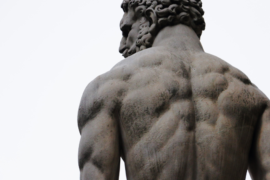The Song
Let me tell you something. You heard those violins and you heard the promise of a generation. You looked up. From your phone or your knitting project or your banal conversation. At home or at the Trop, you looked up.
Five years of orchestra and I cannot tell you where to place your fingers to sound the notes. That skill’s the first to go. But the bow strokes, short and crisp punctuated with longer, lingering ones, the posture of the violinist leaning into the instrument with hair flying and wrist quivering, these things I can recreate in my mind if not in life.
Past those opening measures, the drums and guitar round out the melody, emphasize the downbeats and build a cathedral for the chamber music. Then the singing starts and the song is ordinary. A Nickelback soundalike groans about his problems, and you remember why the song is called Down and Out, and by lyricism alone it is the furthest thing from motivating. But that doesn’t matter. For all practical purposes, the song is only fifteen seconds, and its opening lyrics (only lyrics) sound over a loudspeaker from a booth on high.
Your third baseman…number three…Evan Longoria!
Of course it’s Evan’s song. Would we remember it the same way if it belonged to Sam Fuld[1] or Reid Brignac[2]? Evan was the corkboard where we pinned all our dreams. The first of his kind for this team, this city.
A Short History of the Tampa Bay Rays
My team is younger than I am, and I am not particularly old. When the Tampa Bay (Devil) Rays first sprang into existence, they were a retirement home for washed talent. Wade Boggs,[3] Jose Canseco[4], they whiled away their twilight years in the Florida sun. God’s waiting room. Homegrown stars were few and far between. Sure, we would soon see a few. Speedster Carl Crawford[5] stealing bags and making acrobatic catches in left field. Workhorse Rocco Baldelli[6] who endured genetic illness and found new life in coaching. But the Rays were not known for stars.
We must mention payroll. There is no talking about the Rays without payroll, just as there is no omitting the sparse fan base and tin can stadium from any discussion. Small-market teams are far more common in baseball, due to the historic exclusion of a player salary cap. Tampa Bay has consistently ranked bottom five in how little they pay their players, and we can go on at length about reasons why, but the relevance is this. The Rays pluck talented minor leaguers from their farm system, ride out the initial curve of their success, then flip the players on the trade market faster than you can replace them on banners and posters. I exaggerate, but only slightly. The adage said among fans, past and present, when a player achieves renown: guess we’ll see them in New York/Boston/LA pretty soon.
Enter Evan Longoria.
The 2008 Bandwagon
I’m in the eighth grade, thirteen-fourteen. Again, older than the team. I can offer this as a feeble excuse for my new attention to the Tampa Bay Rays, and therefore baseball, on this most cliched of years. Really the bandwagoner was my father, who’d started putting the Rays on TV after noticing their recent upswing, a string of games won and a slow climb up the standings. He came to America at the peak of Michael Jordan’s career, he is unused to losing. It is why I see the Rays in white and navy and powder blue, rather than their previous green and gray. You can argue aesthetics all you want, but with the name change came steady notoriety, and 2008 marked the arrival of a third baseman with gap teeth and stick-out ears, twenty-three years old and already the harbinger of doom, thanks to a confident swing and killer walk-up song.
Evan Longoria was drafted third overall in the 2006 MLB draft, and his ascent to the major league starting lineup in less than two years is both astonishing and unsurprising. He was the franchise’s Great White Hope[7]. You’ve seen them elsewhere, Mike Trout[8] for the Angels and Aaron Judge[9] for the Yankees, homegrown players with long-term hopes, a face for billboards and a clear speaking voice to host antismoking PSAs and razor ads.
Longoria hits his first home run on April 14, 2008, the day after my thirteenth birthday, and two days after he makes the major league roster for the first time. That season earns him an All-Star Game nod, Rookie of the Year, and more importantly, a trip to the playoffs. Unprecedented in Rays history.
The Rays stumble into the World Series and lose. I watch every game of the playoffs with my father, most of them standing up, our hands laced behind our backs as we pace in front of the TV. I remember home runs over the Monster in Boston, stolen bases in Philadelphia, but finally the young team falters out, loses to the Phillies in Game 5.
“They’ll be back,” my father says.
The Rays make the playoffs three out of the next five years. We are fans for life.
Evan Longoria: A Retrospective
In 2017, on the heels of several straight playoff misses and a host of injuries, the Rays trade Evan Longoria to the San Francisco Giants for cash and for players no longer associated with the team, names I don’t even remember. A city mourns.
At this point I live in Chicago, I’m in my last year of college, and my ties to the team are as tenuous as a twitter feed and YouTube game recaps. There are talks to move the team entirely, and I’m surprised how much I care, having left Tampa myself.
Evan leaves the Rays as the franchise player. Home run leader, multiple gold gloves, three All Star selections, reputation untarnished[10]. By numbers alone he is the franchise player but not an all-timer. No one will say his name in the same breath as Mike Trout or Aaron Judge, or the Hopes that have come before him. You can point to a number of reasons, batting slumps and injuries and the passage of time. Nevertheless, he represents the Hall of Very Good, an unofficial moniker for what exists in our minds.
Evan brings his walk-up song to San Francisco, and later to Arizona, where he makes it to another World Series game. Rays fans rally behind Arizona for his sake, but are ultimately disappointed yet again.
Did those west-coasters look up too, when they heard the violins?
Now
Much has changed, much has stayed the same. In 2022 the Rays offer a long term contract to their latest hope, shortstop Wander Franco[11]. Talks of moving the team continue. Another World Series berth in 2020 ends in defeat. Star pitchers like Blake Snell[12] and Tyler Glasnow[13] are flipped at the height of their power for prospects and cash. Names and faces keep changing hands.
Generations in baseball move faster than generations in life. Pitcher Aaron Civale[14] plays Down and Out when he warms up, in honor of Evan, who he watched as a child in Little League. The players are younger than I am, far younger than their team, which is still nascent and new by organizational standards. The fans still arrive in trickles rather than droves. Even I have set foot in Tampa Bay only once in the years since. My body remembers the humidity and rain.
Evan Longoria is now thirty-eight years old, with a beard and a wife and two sons. He is not retired but not employed by any teams either, the staticky limbo that might be followed by a ceremonial one-day contract with the Rays, but might not be. On social media he is a doting father, a baseball card enthusiast, any middle-aged father with memories of glory days past.
Do his children look up too, when they hear the violins?
[1] A diminutive yet hardworking outfielder whose penchant for leaping catches led to his own minor legend
[2] A platoon player of little notoriety except his two last names
[3] Who earned his 3000th hit with the Rays, no less
[4] Who, at age 59, still boasts biceps larger than my head
[5] I still have his bobblehead in my room somewhere, with the springs missing and the bat broken off
[6] The inspiration for my entire career in healthcare, and a story for another time
[7] Not always white, but most often, especially in baseball
[8] White
[9] Not white
[10] In 2024 the Rays introduce an alternate logo for their City Connect jerseys, a stingray riding a skateboard. The image is lovingly nicknamed by the fans “Evan Longboardia”
[11] Just…just look him up. I can’t bear to explain any further.
[12] Never forget the premature bullpen call against the Dodgers in 2020. You would’ve finished the inning, Snell. We would’ve won that series.
[13] NL Cy Young winner 2024?
[14] AL Cy Young winn–oh, who am I kidding
MALAVIKA PRASEED is a Pushcart-nominated writer, genetic counselor, and MFA candidate at Randolph College. She is the CNF editor at The Twin Bill and a frequent reviewer for the Chicago Review of Books. Her work has appeared in or is forthcoming in Defunkt, The Twin Bill, The Ear, Identity Theory, Khoreo, and others.
Like what you’re reading?Get new stories, sports musings, or book reviews sent to your inbox. Drop your email below to start >>>
NEW book release
Direct Connection by Laura Farmer. Order the book of stories of which Mike Meginnis says there is “an admirable simplicity at their heart: an absolute, unwavering confidence in the necessity of loving other people.”
GET THE BOOK



